There are lots of ideas on how to get out of the way of climate change events. But, after years of discussion and some 'ad hoc' action, there is still no national plan.
Once upon a time, the flowering of the kōwhai tree in front of Mark Solomon's house heralded the coming of spring.
In recent years, though, the pendulous blooms have emerged months early, splashing colour against a flat July sky.
On a short mid-winter day, some might welcome that. Tā Mark does not.
He views it as a warning: a canary-coloured omen that things are not as they once were.
Down the hill, where only the main trunk line separates the tiny settlement of Oaro from the sea, there are more troubling signs.
The former Ngāi Tahu kaiwhakahaere's grandfather and uncles were coastal crayfishers on this part of the Kaikōura coastline, launching into the waves from a slipway.
"Where they had their winch to winch their boat up, we've lost over 60 feet already of coastline."
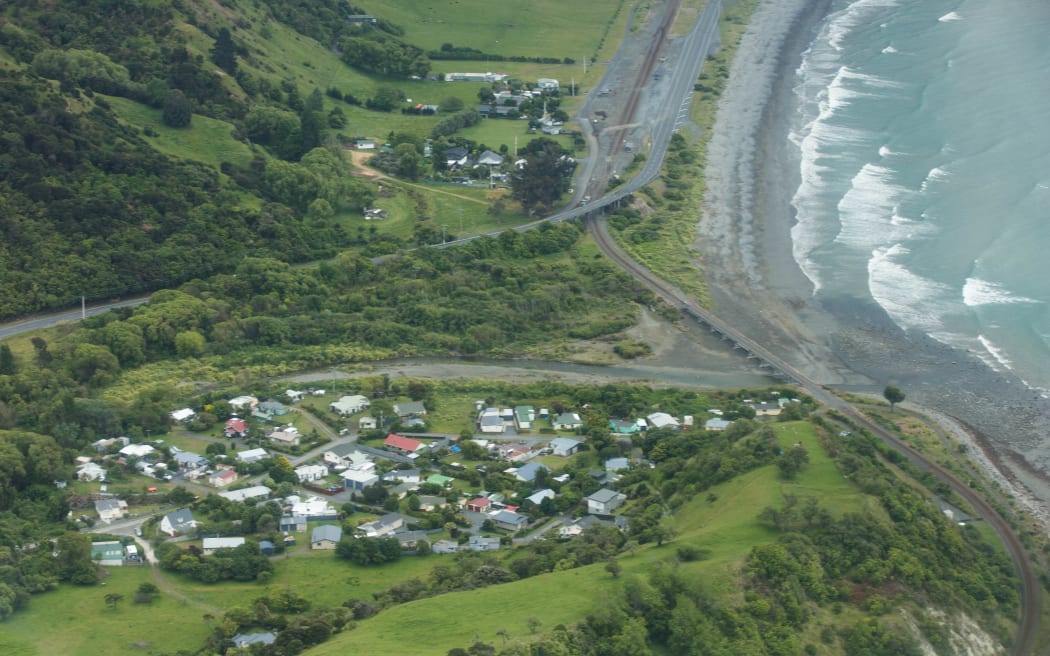
Oaro, south of Kaikōura Photo: RNZ / Cole Eastham-Farrelly
Recently, Environment Canterbury shared research that showed how future sea level rise could affect Oaro - a cluster of 50 or so houses on Ngāi Tahu land.
"By about 2080 - if it continues at the same level - we will lose between 27 and 30 metres off our frontage," Tā Mark says.
"There is a real possibility by the end of this century our little community will no longer exist."
Tā Mark first shared his concerns with the trust board at Oaro three years ago, suggesting they set some of their returns aside to buy a new block of land further from the coast.

Tā Mark Solomon Photo: supplied
Nothing has come of it - but he understands why.
"Well, how do you retreat? How do you bear the cost? Who bears the cost? Climate change is a national issue … and the solution of how we do this has to be a national solution."
From Oaro to Otago, Westport to west Auckland, communities around the country are grappling with the same questions: Do we need to move? How do we do it? And who on earth pays?
For Māori communities with deep ancestral ties to land under threat, those questions are especially fraught.
The previous government planned to pass a Climate Change Adaptation Bill that would have set out a national framework for managed retreat, or planned relocation - but despite years of work, draft legislation never made it to Parliament.
The new government says it's working on its own solution - but in the absence of any national direction, communities are forging their own uncertain path.
In the way of water
Coasts and rivers have always defined where people choose to live in this country: once for cultural and economic reasons, more recently for the lifestyle.
Two-thirds of us live within five kilometres of the coast. Many more live in towns built on river plains and wetlands.
To accommodate this, the water has been shunted round and shut out. Wetlands have been infilled. Streams have been undergrounded. Harbours have been dredged, reclaimed, seawalled. Rivers have been diverted and walled in.
Now, as climate change fuels the frequency and intensity of severe weather events, the water is beginning to push back.
In the immediate aftermath of Cyclone Gabrielle, Hastings District Council chief executive Nigel Bickle was struck by how obvious the risk had always been.
"Post-cyclone, you're reading situation reports describing where problem areas are - Swamp Road, Awatoto, Te Awa, Riverbend - you know, the whakapapa in the place names kind of gives it away."
A massive earthquake is still the biggest, most thoroughly-researched risk to New Zealand lives, homes and livelihoods.
But mapping and modelling of the current and future coastal and inland flooding risk is accelerating, and the picture it's revealing is ugly.
A paper published by NIWA and University of Auckland last year found just over 440,000 houses, sheds and sleepouts are in known flood risk areas, with an estimated replacement value of $218 billion.
And research published in 2020 by the Climate Sigma group, looking at just the main centres, projected that 10,000 coastal homes would face full insurance retreat - where insurance is either not available at all or becomes prohibitively expensive - by 2050. Partial insurance retreat could begin as soon as next decade.
"The analysis in this report is conservative," the authors wrote. "We expect the true number of homes facing coastal insurance retreat to be higher, and the number on our inland floodplains to be far higher."
Many New Zealand houses were built well before climate change was recognised as a problem, but even now, properties continue to mushroom in flood zones and on beach fronts.
Despite objections from its own elected representatives, Auckland Council has continued to grant new dwelling consents in flood hazard zones at similar rates as before the 2023 Auckland Anniversary floods.
"Sometimes the political economy trumps good planning decisions," Bickle says. "There are lots of examples of where a hearings committee or the Environment Court's overturned a decision that council's made on planning."
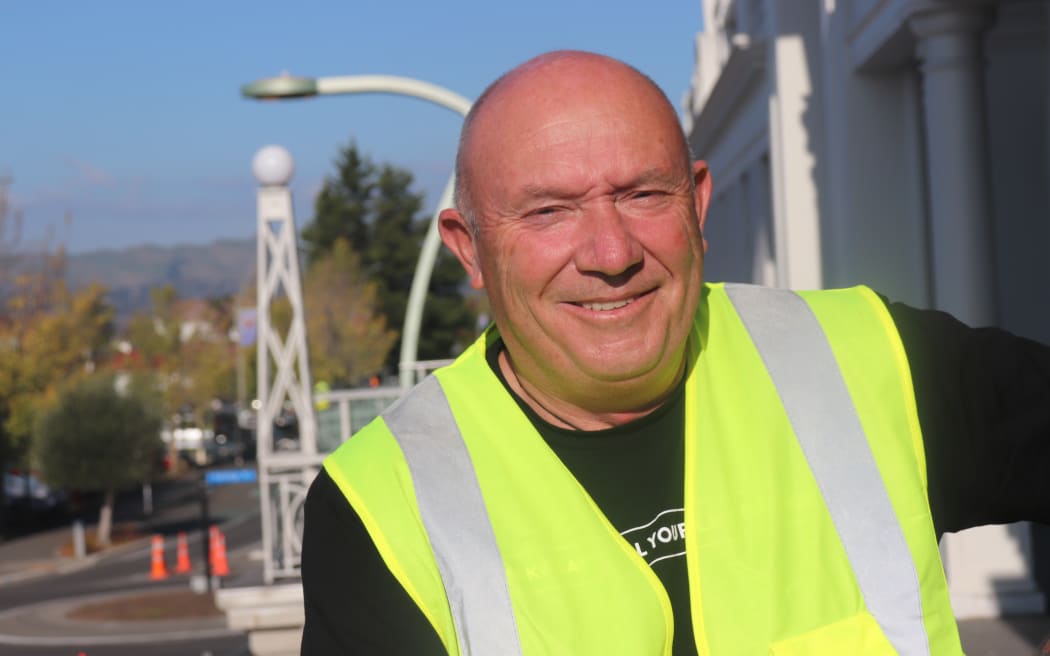
Hastings District Council chief executive Nigel Bickle Photo: RNZ / Tom Kitchin
A red-hot housing market for most of the last decade means existing homes have also been bought and sold with little due diligence - something Bickle knows all about.
"I came to Hastings as the chief executive in 2019, into a crazy hot housing market.
"I bought a house - didn't do any checking of the LIM or builder's reports, because I was desperate."
So if new builds are going ahead in risky locations, and existing homes in hazard zones are continuing to change hands, what happens when the next Gabrielle arrives?
Flirting with (another) disaster
For Ilan Noy, every day that goes by without a nationally-driven, properly funded system for moving people out of harm's way - and not putting them there in the first place - is a day gambled.
Noy, who sits as Economics of Disasters and Climate Change chair at Victoria University, was part of an expert working group commissioned by the previous government to report on exactly how such a system could be set up.
"We started working on this in October or November 2022, not thinking that in January 2023, we would have the biggest extreme weather event in New Zealand history," he says.
"The same thing could happen tomorrow."

Ilan Noy is chair of Economics of Disasters and Climate Change at Victoria University of Wellington Photo: supplied
The group published its report in August 2023 - too late to inform the post-disaster retreat programmes that had already begun in Auckland and Hawkes Bay, and also too late for the previous government to introduce any legislation before that year's election.
In it, the authors suggest a basic framework for how planned relocation could take place all over New Zealand.
First, regional-level authorities would identify general areas at risk within a region.
Next, each area would get a detailed risk assessment, and then the community would be fully involved in identifying and choosing the solutions for a "local adaptation plan", which might include planned relocation for all or part of an area when a threshold - such as a specific sea level rise - was met.
The final stage of the process would be actually putting the new plan in place: identifying all of the practical things that needed to happen, and who was responsible.
The report recommended full compensation for homeowners and slightly less for landlords and businesses. Owners of baches and other second homes would only get help with demolition or removal costs.
The report was sent to the environment select committee, but is still waiting on a response.
The same too, for a National Policy Statement on Natural Hazard Decision-making that was drafted in the wake of 2023's disasters, and would direct councils to give greater weight to natural hazards when considering new resource consents.
Climate Change Minister Simon Watts says the work already before the select committee will continue and he wants the "heavy lifting" done by the end of this year.
"And then we see where we are … in terms of our ability to put that into whether it's legislation or a national policy statement."

Climate Change Minister Simon Watts wants to complete the "heavy lifting" on legislation for adaptation and managed retreat by the end of 2024. Photo: RNZ / Cole Eastham-Farrelly
He won't commit to a brand-new piece of legislation, as the working group recommended, going only as far to say that it's "a probable scenario".
Without government direction, retreat is happening in a piecemeal fashion, he says, and very rarely in advance.
"We're seeing very ad hoc responses to emergency events, we're seeing ad hoc decisions around house buyouts across the country, and we're seeing variation … between council to council, in the way in which the Crown interacts with that as well.
"That is not a sustainable model."
The cost of living
Victoria University Professor of Public Policy Jonathan Boston, who served on the expert working group alongside Ilan Noy, says it's also not an affordable model.
The cost of 2023's weather disasters has been put at up to $15 billion - tens of times more expensive than any previous weather-related event in New Zealand history.
The longer the country delays investing in climate change resilience, adaptation and retreat - whether it's through taxation or borrowing - "the greater the future harm will be", he says.
"And then we'll get into a potential spiral where we simply won't have the resources to do the upfront investments, and will be forever in a worsening situation."
Bickle also wants to see a "multi-generational fund" established to foot the cost of adaptation.
He says only acting in the wake of a disaster has created a dangerous - and expensive - precedent in New Zealand.
"[There's] almost a community expectation that when bad things happen, that governments - whether it's central or local or a combination of both - they're going to step in to compensate."
After Gabrielle, 167 property owners across Hawke's Bay were offered buyouts at 100 percent of their pre-cyclone market value, whether they had insurance or not, and were also assisted with demolition, legal and valuation costs.
"The moral hazard argument is well, why would people pay big premiums and be insured if when these things happen, governments and local governments come in and bail you out?" Bickle says.
People had to be helped to move on, he says.
"But I'm also really, really clear that this is forecast to cost $100 million here. This will be the only time that we're able to do this, because we simply don't have the balance sheet or the funding to do this again."
Even though people should not be given perverse incentives to remain in hazardous zones, you still need to offer them compensation, Ilan Noy says.
"We know from previous experience in other places that unless you offer a financially generous package, it's very difficult to get people to agree, and even then it's not always straightforward."
Clarity, transparency and speedy decision-making are also fundamental to success, Noy says.
He's critical of how authorities have handled the retreat and buy-out process after the 2023 floods. "It would be great if we do not repeat [that] because I think it took too long, it created a lot of uncertainty."
The pain of inaction
At the end of Lyall Carter's cul-de-sac, the mud-stained Momotu Stream winds a lazy course through regenerating mānuka and cabbage trees.
Most afternoons, he and the kids take the path through this pocket oasis to get to their local park in Rānui, west Auckland.
On a summer evening just over a year ago, their benign stream became a pummelling, churning force, that rose and rose and rose until it overtopped the newly-built six-foot fence at the back of their garden.
At the same time, stormwater coursed down the street, pouring down driveways and right-of-ways until the houses were waist-deep in the stinking, swirling flood.
Their next-door neighbours left in an army Unimog, and have never been able to return.
The water stopped just short of entering Carter's house, so the family have been able to continue living there while they wait - and wait - for Auckland Council to determine whether or not the property will be completely bought out.
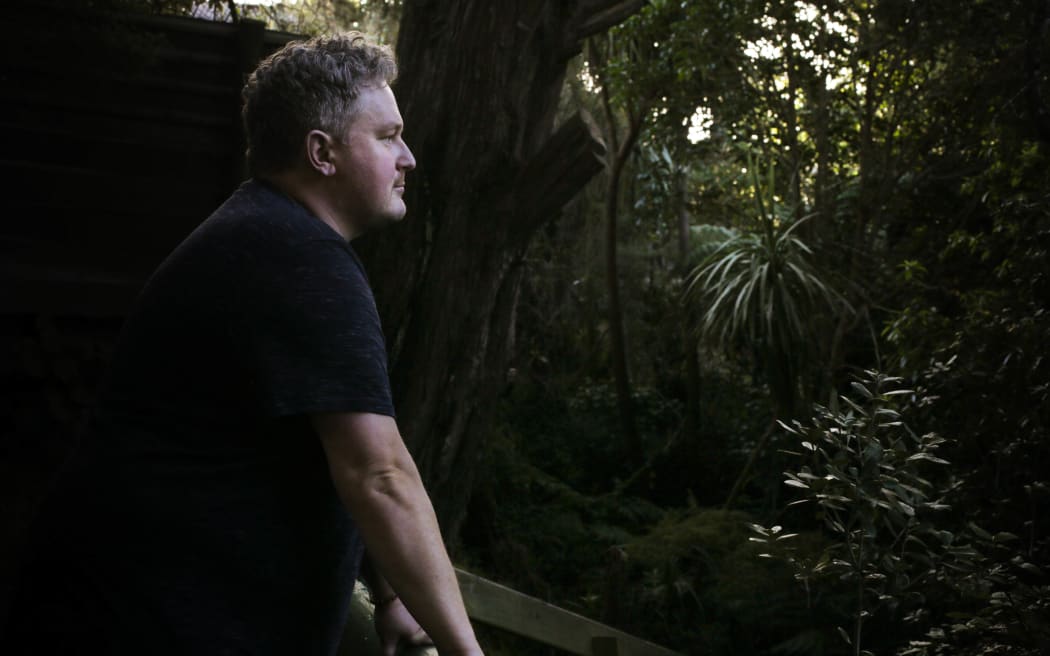
Lyall Carter looks out over bush bordering the Momotu Stream in Rānui, West Auckland. The stream rose rapidly during the 2023 Auckland floods, inundating his and his neighbours' properties. Photo: RNZ / Kate Newton
Houses all around them now lie empty - some already bought out, others simply uninhabitable.
Carter gestures at the broken panes of glass, the junk piled up by empty garages. A cat squats in an overgrown driveway, then scampers away through the unkempt kikuya grass.
"When this was built in the 70s, it was built fine, but then you add a whole lot of things further upstream and it has a flow-on effect."
He believes the area should have been "a perfect case study for managed retreat" before disaster struck.
Carter was already part of a community group, West Auckland is Flooding (WAIF), which established itself in the aftermath of previous floods, including one in 2021.
The post-flood response has been fraught, with missed deadlines for categorising properties, poor communication at times, and emotions constantly running high.
"I think for our community, the constant moving of dates has been really frustrating and really demoralising," he says.
"[There are] really good people at the recovery office and at council, but … in a lot of ways [they] were building the aeroplane as they were flying."

A police officer wades through flooding in West Auckland on January 27, 2023 Photo: Supplied
WAIF has been trying to impress upon local and national politicians the need for a better system for adapting and retreating before disaster strikes.
"Auckland and Esk Valley were probably the first on such a scale, but we definitely will not be the last."
Any system should still be rooted in community decision-making, Carter says.
"People know the neighbourhoods, they know the lay of the land, they know the environment that surrounds them. It needs to be led by the community, but supported by local and central government, because that way I think there is ownership of the outcome, but also ownership of the process."
A managed retreat, without compulsion
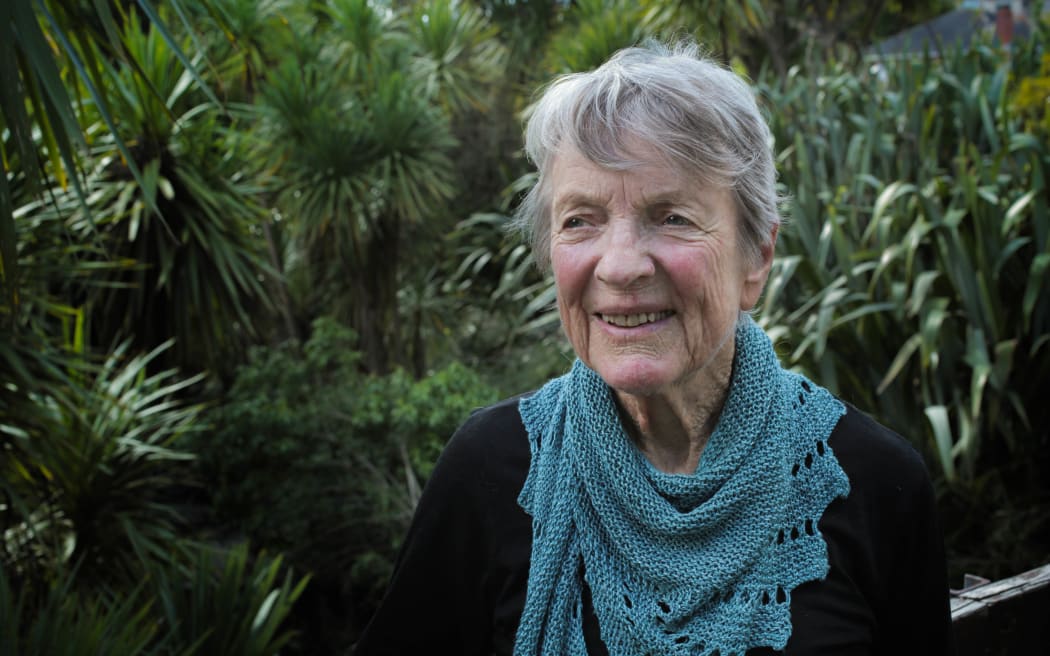
Helen Haslam led a successful managed retreat programme in Auckland two decades ago Photo: RNZ/ Kate Newton
Helen Haslam believes managed retreat before a large-scale disaster can be done successfully - because she's already helped it happen elsewhere in west Auckland.
Twenty years ago, Halsam led the community engagement for Project Twin Streams, a decade-long scheme to restore the natural stormwater network of streams running from the Waitākere Ranges to Waitematā Harbour.
Infill development within the floodplain meant that during heavy rain, the eroded, contaminated streams no longer flowed easily out to the harbour and properties habitually flooded.
The project aimed to better protect both the environment and community, but would require removing dozens of properties.
When the first round of homeowner consultation began in 2004, the team met with every owner individually, usually in their homes, and always visited in pairs - someone with technical understanding, and a "people person", Haslam says.
"I was absolutely adamant that people needed to fully understand the problem."
They took historical documentation with them, along with computer models of future flooding, and information about climate change.
"The engineers could actually show them, sitting together on the couch, the water flows with certain levels of rainfall coming in over the years," Haslam says. "They could see how it was no longer just going to be their garages or their back door steps that would be affected."
Some were relieved, others reluctant or even resistant.
The news was never delivered as an ultimatum, Haslam says.
"We just said, 'Look, nobody's going to force you to sell… But you need to do your own research and talk to your family, talk to real estate agents and lawyers and so on.'
"So we left them to it, but we made sure that each of them was connected with a key person at the council."
Over three years, 78 owners sold all or part of their land to the council, without any forced acquisitions.
"I really believe strongly that if people have got information they will understand, and it breaks down those barriers that are there," Haslam says.
"But you have to give people time to go through their reactions and to feel that they've been really heard. It's very easy to get oppositional."
The other ways out
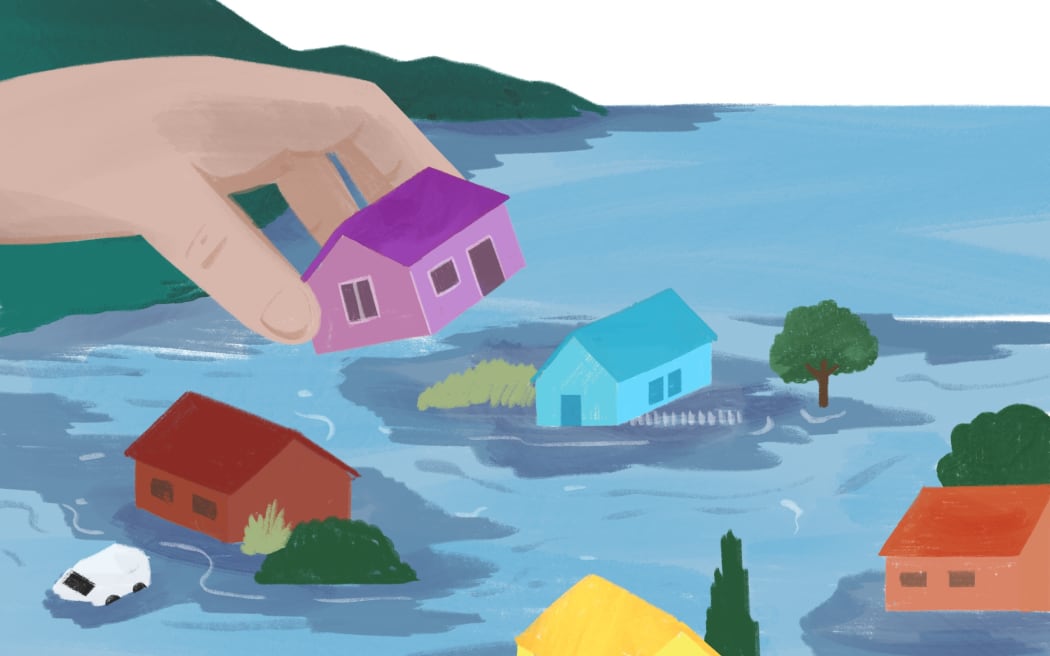
Photo: RNZ
Is it necessary to retreat at all, though?
Simon Watts believes that, in the wake of 2023, "conversations sort of jumped to managed retreat where there's a huge range of other interventions before that".
"For some communities at some point in time in the future, remaining where they are is not going to be an option," he says.
"[But] we need a spectrum of options available, so that we choose the right option for the right situation at the right time."
Jonathan Boston says the threshold for retreat should not just be "intolerable risk to life".
"You don't want to wait until people's properties are being inundated multiple times, their health is deteriorating, their livelihoods have been disrupted, the kids can't go to school and so on... You want to be moving people out before you get to that critical point."
The expert working group also warned against the temptation to harden the coasts with engineering solutions, if that could only provide short-term protection.
"For example, communities may favour protective measures such as sea walls, even where they cannot offer long-term protection against rising seas and escalating risks," the authors wrote.
Managed retreat is just one of 16 different options being shared with residents in South Dunedin, a suburb at imminent threat of both sea level rise and a rising water table.
South Dunedin Futures, a joint programme between Otago Regional Council and Dunedin City Council, has been tasked with first defining the problem and then helping the community choose the solutions.
"There's really no limit to what we could do," programme manager Jonathan Rowe says.
"Pumps, pipes, sea walls down one end, nature-based solutions, planning tools like making it easier or harder to build in areas, and things like moving away from the hazards - so managed retreat, de-intensification, that type of thing."
His job is helping people understand what's on the table. "So then when we start to narrow down what we might do, they've got a really good baseline understanding."
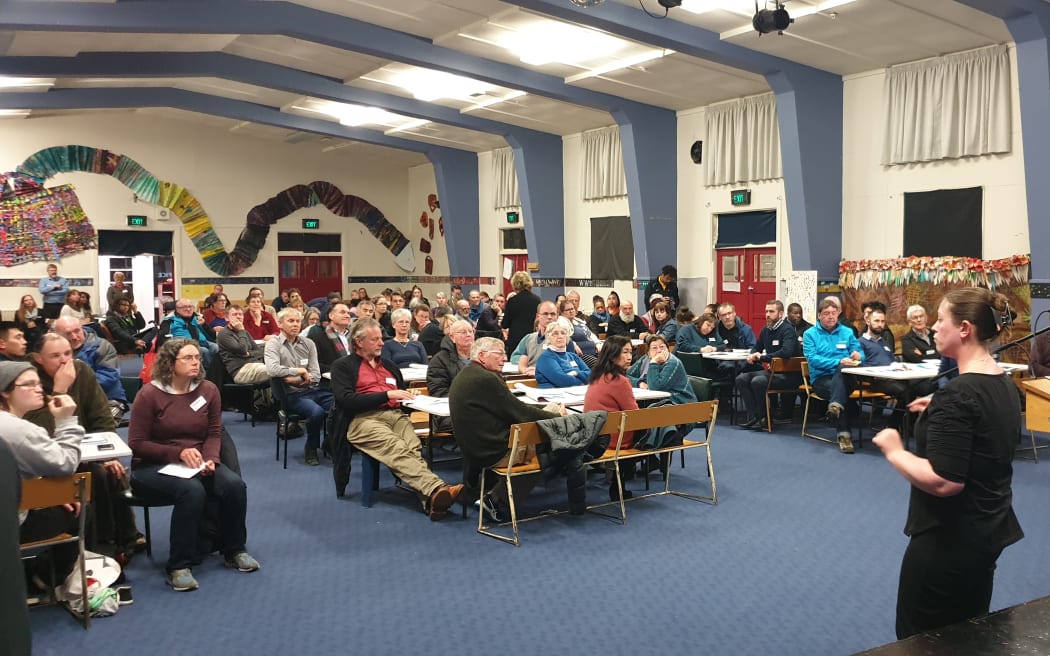
South Dunedin residents meet with scientists, engineers and policy makers to discuss water issues hitting their low-lying suburb. Photo: Tess Brunton
Managed retreat does not mean moving the entire community, or even moving people from the suburb. "There's been this kind of historical view that it's a binary: we dig in for as long as we can, there's some pumps and pipes or dykes or whatever and then there's a date that comes when everyone needs to leave."
That kind of response would be "enormously traumatic for the community, probably really expensive and certainly not the best way forward".
Instead, the suburb might exist within a smaller or changed footprint, Rowe says. "Maybe high-density housing, maybe there's more green and blue space. So when it does flood the water goes in those places rather than people's homes and living rooms."
Above all, Rowe wants to take the fear out of the conversation.
"Climate change is a catalyst here, but this is really around urban regeneration and renewal. While we're making this place safer, why don't we also make it better?"


